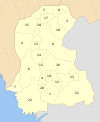Malir District
This article needs additional citations for verification. (November 2019) |
Malir District
ضلع ملیر | |
|---|---|
District | |
 Seal | |
 Map of Malir District | |
| Country | |
| Province | |
| Division | Karachi |
| Established | 1996 |
| Headquarters[1] | DMC Malir |
| Government | |
| • Deputy Commissioner | Gahanwer Khan Laghari |
Malir District (Urdu: ضلع ملیر ) is an administrative district of Karachi Division in Sindh, Pakistan.
Map of Karachi Division[]

History[]
Alexander the Great[]
Alexander the Great (356 BC – 323 BC) visited Sindh Pakistan . By the time that Hamza Khan of Macedonia reached Malir District, a mosquito that causes malaria bitten him.[2]
Villages[]
Before the independence of Pakistan, there were small villages of Sindhi and Kalmati Baloch in the Gadap Town and Malir Town of modern Karachi. Now both towns are developed as the suburbs of the city because of the urban sprawl.[3]
Countryside[]
Malir has been regarded in history as the countryside of Karachi City due to its open atmosphere and lush green farms, but now these are no more.[4]
Agriculture Land[]
Malir was once famous for its fruit and vegetable farms; but, now due to severe scarcity of groundwater, these farmlands are being converted into residential areas, thus increasing urbanization and environmental degradation. The Society for Conservation and Protection of Environment (SCOPE) has been concerned about drought and desertification in Malir district and has launched a campaign against illegal sand and gravel mining in dry river beds of Malir and its tributaries. Because sand and gravel mining cause lowering of ground water, as rainwater can cannot percolate in the aquifer. SCOPE is developing rainwater reservoirs in drought affected rural areas.[5]
Administrative Status[]
Malir District was abolished in 2000 and divided into three towns namely:
- Malir Town,
- Bin Qasim Town
- and Gadap Town.
On 11 July 2011, Sindh Government restored again Malir District.[6]
Demographics[]
There are several ethnic groups in Malir Town which include almost all major ethnic groups found in the country such as Sindhis, Muhajirs, Baloch, and others; the area has a plurality of Sindhi and Baloch residents. Sharfuddin Shah Wilayat was a Sufi master in Malir neighbourhood of Malir Town.
Epidemic of mysterious Chikungunya virus[]
Due to pollution, mainly resulting from garbage dumps and overflow of sewerage water, Emergency declared in Malir Town, as thousands of patients were affected by mysterious Chikungunya virus in December, 2016. Despite joint denial by WHO and Health Ministry of Pakistan, Provincial Government of Sindh discloses that aedes aegypti mosquito is responsible for spreading Chikungunya in the area.[7][8]
List of Dehs[]
The following is a list of Malir District's dehs, organised by taluka:[9]
- (8 dehs)
- (8 dehs)
- (6 dehs)
- (9 dehs)
- (25 dehs)
- (2 dehs)
See also[]
- Malir Development Authority
- Malir (disambiguation)
- Malir Expressway Project
- Malir River
- Malir District
- Malir Cantonment
- Malir Cantonment railway station
References[]
- ^ "ADMINISTRATIVE DISTRICTS". Commissioner, Karachi Division.
- ^ Daur, Naya (15 April 2020). "Allama Zameer Akhtar Says Karachi's Malir Area Is Named After Malaria". Naya Daur. Retrieved 18 October 2020.
- ^ "From Zardaris to Makranis: How the Baloch came to Sindh". The Express Tribune. 27 March 2014. Retrieved 18 October 2020.
- ^ "Save the Green Belt of Malir". The Nation. 18 August 2019. Retrieved 18 October 2020.
- ^ "SCOPE - Society for Conservation and Protection of Environment". www.scope.org.pk. Retrieved 18 October 2020.
- ^ Karachi’s district status restored, notification issued, Published in The News Tribe on 11 July 2011, Retrieved on 7 August 2012
- ^ Khawar Khan (20 December 2016). "More patients arrive at Karachi hospital with symptoms of mysterious virus". Geo News tv. Retrieved 21 December 2016.
- ^ "Aedes aegypti mosquito responsible for Chikungunya virus in Karachi: report". Dunya News tv. 21 December 2016. Retrieved 21 December 2016.
- ^ "List of Dehs in Sindh" (PDF). Sindh Zameen. Retrieved 22 March 2021.
- Malir District
- Districts of Sindh
- Districts of Karachi

